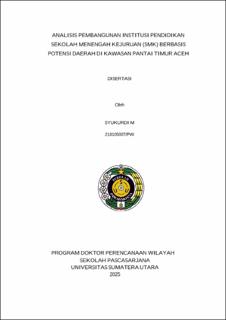Analisis Pembangunan Institusi Pendidikan Sekolah Menengah Kejuruan (SMK) Berbasis Potensi Daerah di Kawasan Pantai Timur Aceh
Analysis of the Development of Vocational High School Education Institutions Based on Regional Potential in the East Coast of Aceh

Date
2025Author
M, Syukurdi
Advisor(s)
Badaruddin
Lubis, Suwardi
Charloq
Metadata
Show full item recordAbstract
Vocational high schools (SMK) play a crucial role in enhancing the quality of human resources aligned with regional potential. However, in the East Coast region of Aceh, SMK graduates often face long waiting periods before securing employment. Many companies and industries prefer to recruit workers from outside the region, leaving local graduates without suitable opportunities. This situation highlights the need for more effective development strategies to optimize the potential of SMK graduates, enabling them to compete in the local job market and meet the region's workforce demands. This study aims to (1) analyze the potential for developing SMK based on regional strengths in the East Coast of Aceh and (2) determine priority strategies to improve the effectiveness of SMK development in the area. The methods used include simple linear regression to evaluate the relationship between SMK graduates and relevant variables, such as the alignment of their skills with market needs. Additionally, the Analytical Hierarchy Process (AHP) method was used to establish priority strategies based on criteria such as leadership, school governance, and educational management. The findings indicate that SMK in the East Coast of Aceh has significant potential, with the variable Y1 (Working in a Job Matching Skills in Aceh) at 81%, Y2 (Working in a Job Matching Skills outside Aceh) at 82%, Y3 (Working in a Job Not Matching Skills in Aceh) at 87.3%, and Y4 (Working in a Job Not Matching Skills outside Aceh) at 88.85%. Furthermore, 85.4% of graduates pursue higher education or join PT/POLRI/TNI/official agencies (Y5), 32% become entrepreneurs (Y6), and 45.1% remain unemployed (Y7). The prioritized strategies identified include enhancing leadership quality in SMK (weight 0.421) and improving school governance (weight 0.397), aimed at increasing alignment between education and local industry needs. Recommendations from this research include curriculum adjustments, strengthening collaboration between SMK and industry, and support from local government to foster sustainable, locally-driven SMK development
